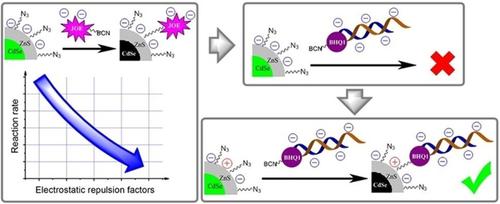当前位置:
X-MOL 学术
›
ChemNanoMat
›
论文详情
Our official English website, www.x-mol.net, welcomes your feedback! (Note: you will need to create a separate account there.)
Electrostatic Repulsion Controls Efficiency of Cu‐Free Click‐Reaction with Azide‐Modified Semiconductor Quantum Dots
ChemNanoMat ( IF 3.8 ) Pub Date : 2020-01-09 , DOI: 10.1002/cnma.201900609 Bahdan Ranishenka 1 , Egor Ulashchik 1 , Aliaksandra Radchanka 2 , Vadim Shmanai 1 , Mikhail Artemyev 2
ChemNanoMat ( IF 3.8 ) Pub Date : 2020-01-09 , DOI: 10.1002/cnma.201900609 Bahdan Ranishenka 1 , Egor Ulashchik 1 , Aliaksandra Radchanka 2 , Vadim Shmanai 1 , Mikhail Artemyev 2
Affiliation

|
Determination of factors influencing the efficiency of conjugation of various molecules with colloidal semiconductor quantum dots (QDs) is an important step toward their biomedical application. We have utilized controlled strain promoted [3+2] azid‐alkyne cycloaddition (SPAAC) as an instrument for studying the influence of charge interaction between QDs and molecules on the efficiency of their conjugation. Azide‐modified polymer‐encapsulated core‐shell CdSe/ZnS QDs, bicyclononyne(BCN)‐modified JOE dye and BCN‐BHQ1(Black Hole Quencher 1)‐modified oligonucleotide duplex were used as model objects for conjugation. Strong surface negative charge of carboxylic QDs was shown to suppress efficient conjugation with negatively charged dsDNA or JOE dye (2′,7′‐dimethoxy‐4′,5′‐dichloro‐fluorescein) molecules. Utilization of zwitter‐ionic QDs with reduced surface charge allows significantly enhance the efficiency of QDs conjugation with dsDNA.
中文翻译:

静电排斥作用控制具有叠氮化物修饰的半导体量子点的无铜点击反应的效率
确定影响各种分子与胶体半导体量子点(QD)共轭效率的因素是迈向其生物医学应用的重要一步。我们已利用受控的应变促进[3 + 2]叠氮炔炔环加成(SPAAC)作为研究QD与分子之间电荷相互作用对其结合效率的影响的工具。叠氮化物修饰的聚合物包封的核壳CdSe / ZnS量子点,双环壬炔(BCN)修饰的JOE染料和BCN-BHQ1(Black Hole Quencher 1)修饰的寡核苷酸双链体被用作共轭的模型对象。羧基QD的强表面负电荷可抑制带负电荷的dsDNA或JOE染料(2',7'-dimethoxy-4',5'-dichloro-fluorescein)分子的有效偶联。
更新日期:2020-01-09
中文翻译:

静电排斥作用控制具有叠氮化物修饰的半导体量子点的无铜点击反应的效率
确定影响各种分子与胶体半导体量子点(QD)共轭效率的因素是迈向其生物医学应用的重要一步。我们已利用受控的应变促进[3 + 2]叠氮炔炔环加成(SPAAC)作为研究QD与分子之间电荷相互作用对其结合效率的影响的工具。叠氮化物修饰的聚合物包封的核壳CdSe / ZnS量子点,双环壬炔(BCN)修饰的JOE染料和BCN-BHQ1(Black Hole Quencher 1)修饰的寡核苷酸双链体被用作共轭的模型对象。羧基QD的强表面负电荷可抑制带负电荷的dsDNA或JOE染料(2',7'-dimethoxy-4',5'-dichloro-fluorescein)分子的有效偶联。



























 京公网安备 11010802027423号
京公网安备 11010802027423号